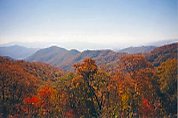BLACK BEARS
-
Frequent
Visitors
to
Gatlinburg
|

|
The
black bear, unique to America, has been studied extensively in the National
Park and much has been learned about its habits and life cycle. There are
estimated to be over 1,000 bears sheltering in the park’s heavily forested
habitat.
The
black bear’s fur varies from shades of light to dark brown, and males are
much larger than females. Although black bears are smaller than grizzlies,
big browns, and polars, they can still weigh up to 400 pounds and stand
six feet tall.
Autumn,
when bears forage for acorns, berries, seeds, insects, and nuts, is the
most important time in a bear’s life. They need to gain three to five pounds
per day to build up enough fat to see them through the winter and spring.
In October or November, bears go into a deep sleep but are not totally
dormant. Females give birth to one or two cubs in January or February.
Because
food is so important to them, bears are great scavengers. The black bear
is a wild and highly intelligent animal and, while not usually aggressive,
can be dangerous if cornered. Feeding bears or leaving food unattended
is therefore a crime. Visitors must properly pack all food and dispose
of scraps. Please do your part to protect these magnificent forest dwellers. |

